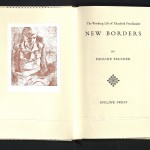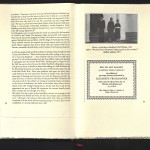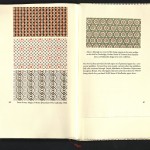Tags
Adolf Hitler, Bauer Type Foundry, Bembo, Berlin Academy, calligraphy, Curwen, Elisabeth-Antiqua, Elizabeth Friedlander, Ellic Howe, English, font, forgery, Francis Meynell, Frankfurt, Friedlander-Antiqua, Georg Hartmann, Germany, Incline Press, Italian, Italy, Jewish, Linotype Corporation, London, Mondadori, Monotype, Nazi, Pauline Paucker, Penguin Books, propaganda, rubber stamps, Sandhurst, Third Reich, typeface, typography, Wehrmacht
New Borders. The working life of Elizabeth…
Pauline Paucker
Oldham, United Kingdom: Incline Press, 1998
Elizabeth Friedlander (1903-1985) produced calligraphy and decorative designs for books from the 1920s until her death. New Borders is based on her workbooks, which she kept throughout her life.
Born into an affluent family, Friedlander studied typography and calligraphy at the Berlin Academy. She worked for the German fashion magazine, “Die Dame,” designing headings and lay-outs, and attracting the attention of Georg Hartmann of the Bauer Type Foundry in Frankfurt. He invited her to design a typeface. This was to become their Elisabeth-Antiqua. It was originally meant to be named Friedlander-Antiqua. However, Adolf Hitler came to power just as the type was ready to be cast. Hartmann suggested that the name be changed from her Jewish surname to her first name.
The font was cut in 1939, after Friedlander left Germany. Under the Third Reich, Friedlander was forced to apply for official registration and was refused a work permit. She moved to Italy, where she was permitted to work so long as she did not become politically active. She learned Italian and worked with the publisher Mondadori, but in 1938, harsh Italian Race Laws threatened her employment. She moved to London, where she learned English and found a job as a domestic servant.
Francis Meynell found work for her as a designer. By 1942, she was in charge of design at Ellic Howe’s propaganda unit, where she produced forged Wehrmacht and Nazi rubber stamps while also working on freelance commissions.
Her most notable work included patterned papers for Curwen and Penguin Books, decorative borders for the Linotype Corporation, printer’s flowers for Monotype, and calligraphy for the Roll of Honour at Sandhurst.
Examples of her work tipped-in. Set in Bembo. Bound in half cream cloth over yellow and green-patterned paper, with a printed paper cover label. Edition of three hundred and twenty-five copies, signed by the author.





Interesting woman, interesting history. Always enjoy your posts, always learn something!